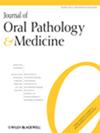Angiopoietin-like 4 is upregulated by amphiregulin and activates cell proliferation and migration through p38 kinase in head and neck squamous cell carcinoma
Abstract
Background
Angiopoietin-like 4 is a molecular hallmark that correlates with the growth and metastasis of head and neck squamous cell carcinoma, one of the most prevalent cancers worldwide. However, the molecular mechanisms by which angiopoietin-like 4 promotes head and neck squamous cell carcinoma tumorigenesis are unclear.
Methods
Using well-characterized cell lines of head and neck squamous cell carcinoma development, including human normal oral keratinocytes, dysplastic oral keratinocytes, oral leukoplakia-derived oral keratinocytes, and head and neck squamous cell carcinoma cell lines, HN13, HN6, HN4, HN12, and CAL27, we investigated the signaling pathways upstream and downstream of angiopoietin-like 4-induced head and neck squamous cell carcinoma tumorigenesis.
Results
We found that both epidermal growth factor receptor ligands, epithelial growth factor, and amphiregulin led to angiopoietin-like 4 upregulation in normal oral keratinocytes and dysplastic oral keratinocytes and cooperated with the activation of hypoxia-inducible factor-1 in this effect. Interestingly, amphiregulin and angiopoietin-like 4 were increased in dysplastic oral keratinocytes and head and neck squamous cell carcinoma cell lines, and amphiregulin-induced activation of cell proliferation was dependent on angiopoietin-like 4. Although both p38 mitogen-activated protein kinases (p38 MAPK) and protein kinase B (AKT) were activated by angiopoietin-like 4, only pharmacological inhibition of p38 MAPK was sufficient to prevent head and neck squamous cell carcinoma cell proliferation and migration. We further observed that angiopoietin-like 4 promoted the secretion of interleukin 11 (IL-11), interleukin 12 (IL-12), interleukin-1 alpha (IL-1α), vascular endothelial growth factor, platelet-derived growth factor (PDGF), and tumour necrosis factor alpha (TNF-α), cytokines and chemokines previously implicated in head and neck squamous cell carcinoma pathogenesis.
Conclusion
Our results demonstrate that angiopoietin-like 4 is a downstream effector of amphiregulin and promotes head and neck squamous cell carcinoma development both through direct activation of p38 kinase as well as paracrine mechanisms.

 求助内容:
求助内容: 应助结果提醒方式:
应助结果提醒方式:


